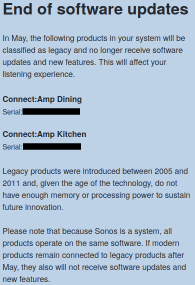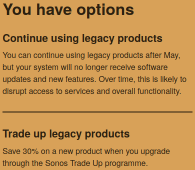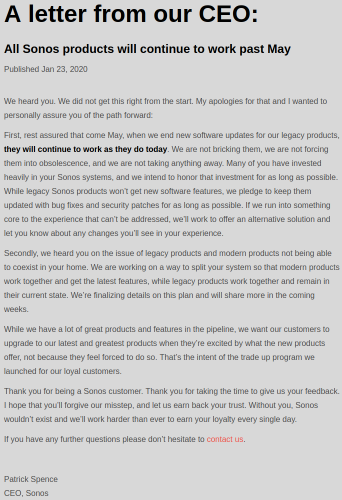In May 2015, when the build phase of our kitchen and dining extension was nearing completion, I bought my first Sonos products, two Connect:Amps. Whilst not cheap, a home audio system was one of the things I had wanted to install in the extension but not wanting wall-mounted or floor/furniture standing speakers creating clutter I decided on ceiling speakers. During the first fix speaker cable was run from three locations back to the cupboard under the stairs as given the layout of the extension I’d opted for three stereo ceiling speakers (Canton 865 DT). Fortunately you can connect two speakers to one Connect:Amp so I needed two Connect:Amps rather than three. Within the Sonos app I then grouped the two “rooms” so that the same audio played out of all three speakers.
In January 2016 I bought a Play:1 for an upstairs bedroom used as a study and then in November 2016 I bought an Amazon Echo Dot (2nd Generation) for the extension ready to add voice control (though Sonos did not enable this until almost a year later in October 2017).
 On 21 January I received an email from Sonos letting me know that from May the
two Connect:Amps I owned would “be classified as legacy and no longer receive
software updates and new features [which would] affect [my] listening
experience.” The email also said “that because Sonos is a system, all products
operate on the same software” and “if modern products remain connected to
legacy products after May, they also will not receive software updates and new
features.”
On 21 January I received an email from Sonos letting me know that from May the
two Connect:Amps I owned would “be classified as legacy and no longer receive
software updates and new features [which would] affect [my] listening
experience.” The email also said “that because Sonos is a system, all products
operate on the same software” and “if modern products remain connected to
legacy products after May, they also will not receive software updates and new
features.”
 The same email then said that I had options and offered two: the first to
continue as is but no longer receive software updates and new features which is
likely, over time, to disrupt access to services and overall functionality. The
second to save 30% on new Sonos products when trading up my legacy ones. Of
course there are other options, more of which later.
The same email then said that I had options and offered two: the first to
continue as is but no longer receive software updates and new features which is
likely, over time, to disrupt access to services and overall functionality. The
second to save 30% on new Sonos products when trading up my legacy ones. Of
course there are other options, more of which later.
Finally the email included a link to a Sonos support article “to learn more about what the end of software updates means for [my] listening experience” and said to contact Sonos if I have any additional questions. This article in turn had a link to another listing legacy and modern products which would be more useful if it included manufacturing periods for all products and serial number ranges to help identify product revisions.
On the same day Sonos published a marketing version of why software updates are ending for their oldest products though they glossed over the impact on existing Sonos customers.
There was so much wrong with the email and support articles!
- Less than 5 years after buying two Sonos products they would stop receiving
software updates which would affect my listening experience
- I can accept not receiving updates but it shouldn’t stop them working!
- It also shouldn’t compromise my listening experience!
- Does this also mean all Sonos products are only supported for ~5 years?
- Because of this my other Sonos product would also stop receiving updates etc.
- Why? Change the system so can run split versions or (preferably) push a “lite” update to older devices (don’t need code for functions they can’t support)
- A hint of blackmail
- Upgrade or else!
- With less than four months until May it was a bit short notice
- 30% off the replacement Sonos product (Amp) is still a lot of money
- 30% off RRP of £599 is more than I paid for each Connect:Amp!
- 30% also doesn’t seem so generous when Sonos offered 20% off home cinema for last year’s Black Friday promotion
- Trading up bricks the legacy product meaning it’s only good for landfill or parts (depending on how it’s bricked)
- Lack of details
This news probably explains the emails from Sonos in November introducing and pushing their Trade Up program, obviously targeted at Sonos customers with legacy products.
Unsurprisingly I wasn’t the only person unhappy with this news and the internet was alive not just with the sound of unhappy and angry Sonos customers but also potential (and now lost) customers.
 On 23 January Patrick Spence, Sonos CEO, published a
letter which I then received
as an email on 25 January. In it he said that “come May, when [Sonos] end new
software updates for [their] legacy products, they will continue to work just
as they do today” and that “whilst legacy Sonos products won’t get new software
features, [Sonos] pledge to keep them updated with bug fixes and security
patches for as long as possible.” However there was a note that “if [Sonos] run
into something core to the experience that can’t be addressed, [Sonos will]
work to offer an alternative solution …” He also said that Sonos are “working
on a way to split [my] system so that modern products work together and get the
latest features, whilst legacy products work together and remain in their
current state. [Sonos are] finalizing details on this plan and will share more
in the coming weeks.” He then went on to say that “[Sonos] want [their]
customers to upgrade to [their] latest and greatest products when [customers
are] excited by what the new products offer, not because [customers] feel
forced to do so. That’s the intent of the trade up programme [Sonos] launched
for [their] loyal customers”. Finally he thanked customers for being Sonos
customers, giving feedback, and “[hoped] that [I’ll] forgive [their] misstep
and let [Sonos] earn back [my] trust.”
On 23 January Patrick Spence, Sonos CEO, published a
letter which I then received
as an email on 25 January. In it he said that “come May, when [Sonos] end new
software updates for [their] legacy products, they will continue to work just
as they do today” and that “whilst legacy Sonos products won’t get new software
features, [Sonos] pledge to keep them updated with bug fixes and security
patches for as long as possible.” However there was a note that “if [Sonos] run
into something core to the experience that can’t be addressed, [Sonos will]
work to offer an alternative solution …” He also said that Sonos are “working
on a way to split [my] system so that modern products work together and get the
latest features, whilst legacy products work together and remain in their
current state. [Sonos are] finalizing details on this plan and will share more
in the coming weeks.” He then went on to say that “[Sonos] want [their]
customers to upgrade to [their] latest and greatest products when [customers
are] excited by what the new products offer, not because [customers] feel
forced to do so. That’s the intent of the trade up programme [Sonos] launched
for [their] loyal customers”. Finally he thanked customers for being Sonos
customers, giving feedback, and “[hoped] that [I’ll] forgive [their] misstep
and let [Sonos] earn back [my] trust.”
Basically a grovelling attempt at damage limitation following Sonos’ Gerald Ratner moment. Patrick used the words “loyal” and “trust” but those are the words Sonos customers (once) thought about their relationship with Sonos. Yes he provided some reassurance but again it was lacking details and suggested that Sonos haven’t actually thought this all through, something my Twitter conversation with @SonosSupport seemed to confirm.
Fortunately I didn’t buy a Sonos Sub in December when I saw it at £465 (a 33.5% reduction against RRP!) on Amazon UK.
Could Sonos have given more than 4 months notice? Not only was the Trade Up program launched on 1 November but Sonos’ Form 10-K for Q4 2019 included a revealing (and prophetic) risk factor (see page 17 of the PDF).

Would more notice have made any difference? Not really and I actually think it would have been worse for Sonos if it had been coupled with the launch of their Trade Up program which has been derided for not being environmentally friendly.
With all of Sonos’ blog posts and support articles it surprises me that one of the most useful pieces of information is a graph published on the Facebook page for Phonos (Sonos App) which shows memory and storage of Sonos products.

Personally I think Sonos should publish this information on their web site rather than leaving it to a third party to do so.
The same Facebook page also has a tip for finding out the amount of memory and
flash storage in your Sonos products - for each product visit
http://ipaddress:1400/xml/device_description.xml (replacing ipaddress as
appropriate) and then look for <memory> and <flash>.
If you’re a Linux or Mac user you could use the following command (possibly in a loop of IP addresses) to get this information.
$ curl --silent http://ipaddress:1400/xml/device_description.xml | egrep '\<(displayName|roomName|memory|flash)\>'
Unfortunately this confirmed that both my Connect:Amps have 32MB of both memory and flash storage. However my Play:1 isn’t far behind with 128MB of memory and 64MB flash storage so I don’t think it will be long before that is reclassified as legacy.
As for what to now do, my options would appear to be
- As per Sonos’ first option do (and purchase) nothing and see what (if
anything) happens in May
- This is the cheapest option, at least in the short term
- As per Sonos’ second option trade up legacy Sonos products
- At 30% off this is costly and each trade up would cost me more than I paid in the first place
- Discount needs to be improved
- Can’t combine trade ups to get bigger discount off one Sonos product
- Will trade up be possible from May?
- Sell legacy Sonos products
- Whilst I haven’t been tracking Sonos resale values, prices don’t seem to have plummeted though I think they are on a downward trend
- Equivalent replacement Sonos products are still expensive
- Would need to replace with (or do) something else
- Sell all Sonos products
- Would lose some money but at least I hadn’t (yet) spent thousands
- Ceiling speakers in extension would still remain
- Whilst I could manage without Play:1 in study I’d need something to drive three, or at least one, ceiling speaker
- Would need to replace with (or do) something else
- Buy more legacy Sonos products
- Gamble that legacy Sonos products will still work from May
- Second-hand legacy Sonos products are (considerably) cheaper than new modern Sonos products
- Risk of buying legacy Sonos products that are in Recycle Mode
- Buy more modern Sonos products
- Trading up legacy Sonos products for modern Sonos equivalents wouldn’t add to my Sonos system
- Before this news I was thinking of one or two amps and a soundbar (latter would require a new TV)
- What happens in 5 years time?
- Buy IKEA
SYMFONISK
products
- Cheaper than buying Sonos Amp plus ceiling speaker(s) for bedrooms
- Buy Amazon Echo Link Amp
- I have an Amazon Echo Dot
- Whilst cheaper than Sonos Amp I’ve read some bad reviews
- Doesn’t appear to support Google Play Music/YouTube Music
- Buy/do something else
I like Sonos and don’t want to see them fail, not least because that could affect the operation of my whole Sonos system and not just the legacy products, but the market has changed since I bought my Sonos products and there are now alternatives.
ZDNet recently published an article on the idea of an open source audio system but I can’t see Sonos et al backing this. However I do think open source is the way to go and as a Raspberry Pi enthusiast I’m already thinking of using these with DAC HATs - HiFiBerry have already confirmed to me that their Amp2 HAT can easily handle my ceiling speakers. Two attractions of a Raspberry Pi-based solution are cost and flexibility but it will require some time to investigate and implement.
Stay tuned.
Simon